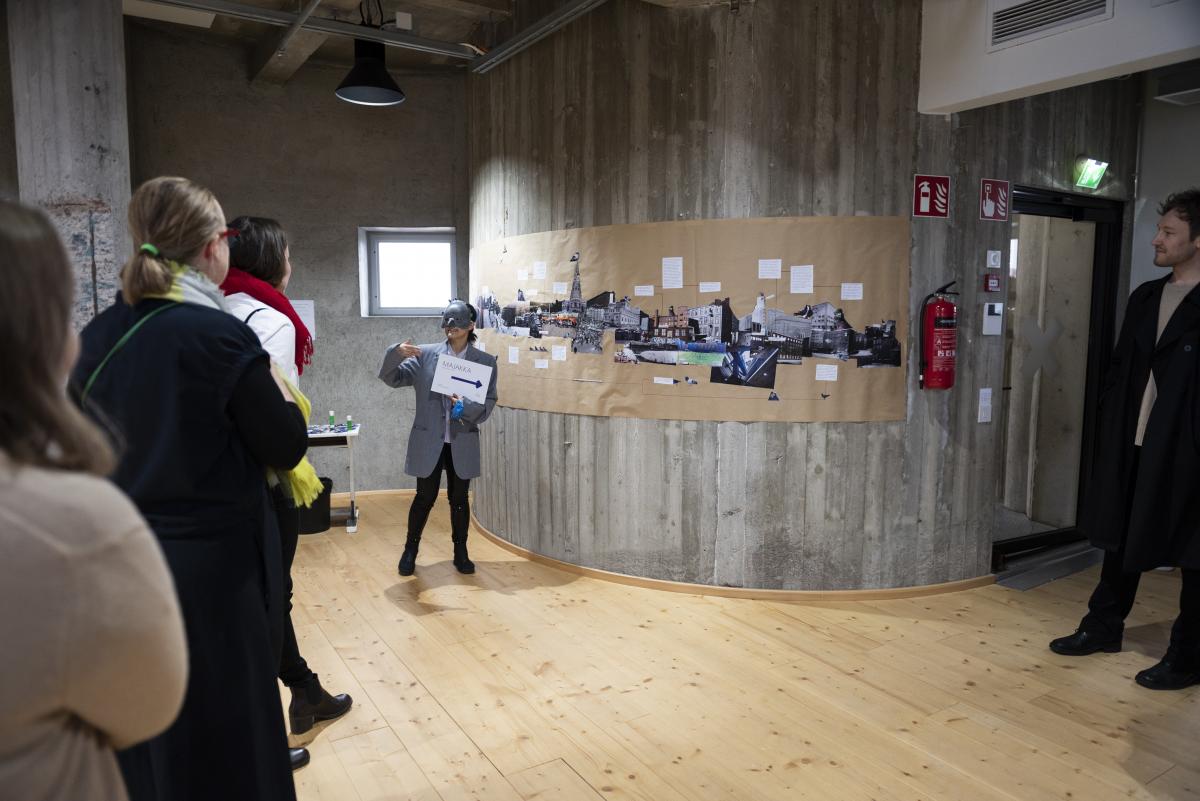The Urban Pigeon Project as a part of LAPSODY festival is where we are gathering for rehearsing hospitalities
Written by Ladapha Sophonkunkit, student in Live Art and Performance Studies.

Coo coo… coo…coorrr rrr rrr
On the school rooftop’s corridor, pigeons softly landed. They were seeking some seeds and a cozy spot to stay. Would they know that this art school building is a former bread factory?
Our group presented our installation piece at Majakka space on the 6th floor of the Academy of Fine Arts building. There are various sections in our exhibition. We designed a cozy bird nest that enables visitors to explore Helsinki’s historic pigeon wall and register the location of any pigeon sightings. All guests would receive free seeds in a paper bag along with instructions on how to construct a dovecote as part of our presentation. Additionally, there is a manifesto that introduces the concept of coexisting with urban pigeons and a series of brief videos that capture these interactions.
The highlight was the panel discussion that happened in the same space. For the panel discussion, we brought two experts, Dr. Nina Nygren and Mai Kivelä. Dr. Nina Nygren is a post-doctoral researcher in environmental policy at Tampere University. She specialises in urban animals and conservation policy. Mai Kivelä, a longtime political activist from Helsinki and member of the parliament, serves on the city council. She specialises in issues relating to the environment, the climate, and animal rights. Even though the majority of our exhibition was devoted to urban pigeons, we also discussed the coexistence of other animals in urban areas. How we would want to envision coexisting and redesigning a metropolis not only for humans and a chosen animal, but also for other existing non-human creatures. Having two experts in the discussion added another layer of meaning. They brought up the importance of animal rights when talking about zoning legislation. It inspired fresh ideas about how to take multiple species into account while designing or planning cities. We need to acknowledge that non-human species also have rights, which is why it is necessary to have this kind of conversation.
I was a pigeon tour guide, leading guests from Tori in the Theatre Academy Lobby area to the Majakka space. Before everyone arrived at the space, I introduced myself to the visitors while casually sharing pigeon information I had learned over the working process and wearing a pigeon mask and costume.
Coo coo… coo…coorrr rrr rrr coo coo…
Becoming a pigeon and trying to be friends with pigeons.
Our group member was imitating pigeon noises as a way to communicate and call for pigeons.
Would they like the seed we give?
If they could comment on the design of a dovecote what would they say?
I had the idea after four days of performing as a pigeon. What kind of agency do pigeons and artists have in common? We can sometimes be considered as a symbol of something, especially if it offers benefits, or we can just be a burden on society who constantly needs to defend our own existence (or even worse when pigeons can not justify themselves). The fact that we could invite a member of the parliament to speak about this in a setting like an art school was very enlightening. Then, that also had an impact on how I typically perceive or position myself in society. I did not get along well with those in positions of authority back home. It was more than I could have imagined when our voice was heard and shared.
Ultimately our project raised some fundamental yet seldom asked questions. Who does the city belong to? What voice has gone unnoticed? How might artists play a part in provoking questions and thoughts? Can we really make a world where all species can live in harmony?
I hope that’s where things start.
When performance
The master’s programme in Live Art and Performance Studies (LAPS) was launched in 2001 as a Finnish-language degree programme, Esitystaiteen ja -teorian koulutusohjelma. Since 2013, LAPS has been an English-language, international and residential MA programme based in Helsinki. The objective of the programme is to enable artists coming from different environments, classes, cultures and upbringings to focus on their work, develop their research and map out the future of their artistic practice. This blog discloses the various aspects of the LAPS programme, from individual notions and statements by students to providing background for LAPS MA thematic interests.
Learn more about the LAPS programme
Latest posts
Follow blog